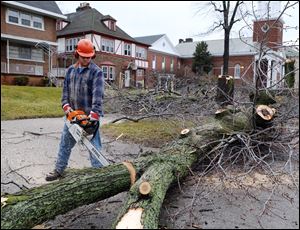
Tree clearing advances Collingwood Boulevard’s $3.4M reconstruction work
2/1/2013
Eddie Curry of the Toledo Division of Parks and Forestry cuts a tree into smaller pieces after it was felled along Collingwood Boulevard north of Bancroft Street. The trees are being cut down in preparation for a road-reconstruction project. The construction contract has not been awarded yet.
City crews have begun removing six dozen trees along Collingwood Boulevard in preparation for a $3.4 million street reconstruction, trees a neighborhood activist had hoped to save by forcing the project to be redesigned.
Jen Sorgenfrei, a Bell administration spokesman, said the Ohio Department of Transportation gave the city the go-ahead last week to start the tree clearing.
An internal administration memo stated that “Section 106 consulting parties will be given 15 calendar days to review and comment on the revised plans when they are available.” Section 106 refers to federal historic-preservation regulations.
But the removal of 72 trees, mostly honey locusts, along Collingwood between Monroe Street and Islington Avenue began Tuesday.
“This is supposed to be under review,” David Neuendorff, an Old West End resident who fought the project, said Tuesday evening.
David Dysard, the administrator of public service at the city division of engineering services, said Thursday that ODOT, which administers the federal funding for Collingwood, had given the city clearance to proceed on Jan. 24.
But in an email sent Thursday to ODOT officials, Mr. Neuendorff said the city and state are violating federal law by allowing the trees to be cut before interested parties were allowed to review and comment on the project's final plans.
“I would suggest to you that you stop the damage until such time as the facts are ascertained,” he wrote to Kacey Smith, the district environmental coordinator at ODOT's Bowling Green district office.
Mr. Dysard said he was not familiar with the Advisory Council for Historic Preservation's involvement in the matter.
“I can't speak to what that is, or what they do,” he said.
Mr. Neuendorff argues that Collingwood no longer needs four lanes, and rebuilding it as a narrower, neighborhood street could save the trees. City and state officials say reducing the street to two lanes plus curbside parking would reduce its width by no more than 13 feet, not enough to avoid damaging the trees' roots during construction.
The honey locusts show stress from years of exposure to road salt, Mr. Dysard said last year. As part of the project, he said, Collingwood's sidewalks will be moved to the curbside so that new trees, when planted, will be farther from the pavement edge but still within the public right of way.
The city has promised to replace the 72 trees, plus 17 more, within a year of completion. Before rebuilding the street's drainage and pavement, the city will replace a failing, 140-year-old water main beneath the street.
The tree-related street closings on Collingwood between Ashland and Bancroft are expected to continue through Feb. 8, between 9 a.m. and 3 p.m. each day.
Contact David Patch at: dpatch@theblade.com or 419-724-6094.